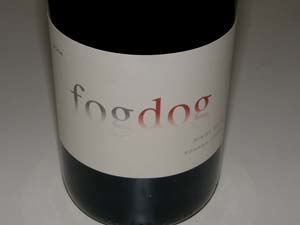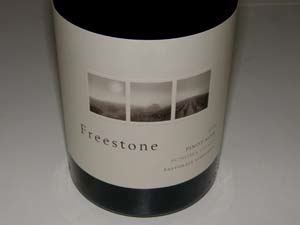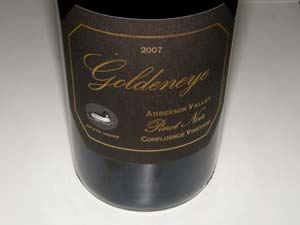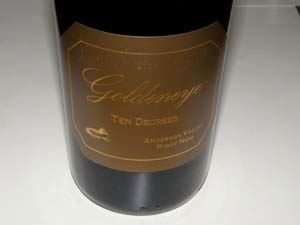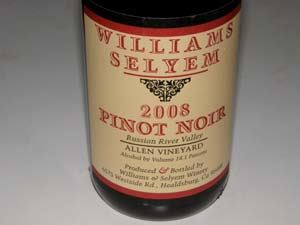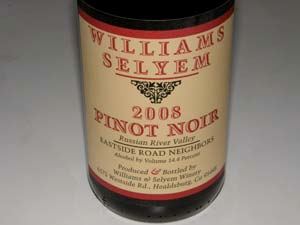Drinking Bigger
Using the term “big” when referring to Pinot Noir wineries is relative. The so-called big Pinot Noir wineries are
still very small compared to some of the giants in the wine industry such as E. & J. Gallo and Bronco Wine
Company. The larger Pinot Noir producers vinify Pinot Noir in the same fashion as the boutique wineries, but
do it on a larger scale, say with 60 large fermenting vessels versus 12 small ones, with access to more
vineyard sources (many of which are estate owned), and more man power. Often a value-priced line of wines
are produced in large quantities to compliment the small lot vineyard-designated Pinot Noirs. Total annual
production is often well over 5,000 cases, but the quality standards are high, and as in the case of the wineries
included below, the wines can equal or surpass those crafted by their small artisan brethren.
Freestone Vineyards
Sonoma Coast, California
In 1999, Joseph Phelps (known for Napa Valley Insignia), his son Bill, and the Joseph Phelps Vineyards
management team purchased a former dairy farm of 89 acres in Freestone, a hamlet in the true Sonoma
Coast. The site was well suited to Chardonnay and Pinot Noir. Planting began the next year with staged
replanting continuing until 2007.
Freestone Vineyard Estate consists of three distinct properties. The Pastorale Vineyard is planted to 34 acres
of Pinot Noir and nearly 22 acres of Chardonnay at the end of Freestone Flat Road adjacent the new
Freestone winery facility. The acquisition of additional property led to nearby Quarter Moon Vineyard (41 acres
of Pinot Noir) and a long-term lease was established for the fruit from nearby Ferguson Vineyard (6 acres of
Pinot Noir).
Growing and ripening wine grapes in this very cool area has been a challenge from the beginning. Yields can
be very low due to poor berry set in the cool days of the spring growing season. It is not unusual to have 45
degree temperature swings in a single day here. There has been a huge financial commitment required to
succeed here.
The 40,000 square foot winery, completed in time for the 2007 harvest, is built into the hillside and employs
gravity-flow by its three level construction. The winery is not open to the public due to local environmental
concerns, but I have visited and found it to be impressive in every way.
The Director of Winemaking is Phelps veteran Damien Parker. The Winemaker is Theresa Heredia who is
assisted by Justin Ennis and consulting Burgundian Pascal Marchand.
The first vintage of Pinot Noir produced from Sonoma Coast grapes was released as the 2004 Fogdog Pinot
Noir from purchased grapes. Fog dog refers to a bright or clear spot appearing in a breaking fog and the name
has been retained for the solid, early drinking and larger production Pinot Noir and Chardonnay wines. In
2005, 600 cases of Freestone Vineyard Sonoma Coast Pinot Noir were produced and by 2006, 2,700 cases.
Beginning with the 2007 vintage, full production ensued, with premium Chardonnays under the Ovation,
Freestone Vineyards Sonoma Coast and Freestone Vineyards Pastorale Vineyard labels, and premium Pinot
Noirs that include Freestone Vineyards Sonoma Coast and vineyard designates from Quarter Moon Vineyard
and Pastorale Vineyard.
The 2008 Freestone wines were unaffected by the smoke from fires, possibly because the Freestone vineyards
sit in a fog layer.
The Freestone Vineyards Guest Center is open for tasting Thursday through Monday from 11-5, located at the
corner of Bohemian Highway and Highway 12 (Bodega Highway) in the stylishly remodeled Pastorale building.
The Fogdog and Freestone wines are particularly popular at fine restaurants. These wines, along with the
vineyard-designated Chardonnay and Pinot Noirs are sold through the tasting room, the website
(www.freestonevineyards.com) and the winery’s wine club (Freestone Private Collection).
2008 Fogdog Sonoma Coast Chardonnay
13.5% alc., 2,500 cases, $35. 14% estate vineyards and 86%
independent growers.
·
Light straw color in the glass. Appealing scents of creme brulee, butter, willow bark and
honey. Moderately rich on the palate with crisp flavors of white stone fruits, apple pie, honey, melon, spice and
a hint of bourbon. I like the fact that this wine is not burdened by oak as so many lesser priced Chardonnays
are prone to be. This wine is very user friendly and will have widespread appeal. Buy this by the case to drink
now. Good.

2008 Freestone Sonoma Coast Chardonnay
13.5% alc., 800 cases, $55. Composed of 100% estate
grown fruit.
·
Light straw color and clear in the glass. Demure scents of spiced apples and white
peaches. The apple, peach, citrus and pear flavors flood the mouth with flavor, but the wine has an
appealing modesty. Slightly viscous in texture, there is no oak intrusion, and bright acidity brings the
fruit into focus. A very classy Chardonnay with modest alcohol that adds to the appeal.

2008 Freestone Pastorale Vineyard Sonoma Coast Chardonnay
13.5% alc., 50 cases, $100. Before pressing, the whole grape clusters
were lightly crushed by stomping on the grapes in the bins to liberate
some grape solids and facilitate the extraction process during pressing.
After native yeast fermentation, the wine was aged 16 months in a large
oak puncheon, with bi-monthly bâtonnage.
·
Light golden, clear straw
color in the glass. Needs some coaxing to open in the glass, but over time offers
an alluring perfume of apple pandowdy, Asian pear and buttered toast. Similar in
flavor profile to the Sonoma Coast bottling, but with added notes of roasted nuts,
minerals and lemon zest. A sneaky wine that picks up intensity and interest with
swirling in the glass and provides a full-on explosion of flavor after 30 minutes. A subtle creaminess and hi-tone
acidity add to the appeal. Worth the tab for serious Chardonnay aficionados and in the same class as
other top producers of Chardonnay in California such as Peter Michael, Kistler, Littorai, Hanzell and Ramey.

2008 Fogdog Sonoma Coast Pinot Noir
13.5% alc., 8,000 cases,
$35. A blend of fruit from all three of the Freestone estate vineyards.
·
Moderate reddish-purple color in the glass. Highly perfumed out of
the bottle with bright aromas of black cherries, berry jam, rose petals,
spice, caramel and toast. Achieves more aromatic interest over time
in the glass. Hi-tone and moderately intense blueberry, raspberry and
cranberry fruit flavors with notes of pomegranate, framed by bright
acidity. Still sporting dusty, dry tannins that will integrate over time. A solid daily
drinker that will work beautifully at the dinner table for the next few years. A
wine to buy by the case for the Holidays. Very good.

2008 Freestone Quarter Moon Vineyard Sonoma Coast Pinot Noir
13.5% alc., 120 cases, $120. For
winemaker Theresa Heredia, this is one of the most naturally made wines she has produced. Picked at 23.5º
brix with a minimal acid addition. The wine was 100% whole cluster fermented in an oak tank. 80% new oak.
·
A cornucopia of bright berry aromas is highlighted with scents of alluring exotic spice, sweet pipe tobacco and
toasted oak. The purple fruit flavors are vivid and high-strung, fueled by vibrant acidity with toasted oak playing
a background role. Noticeable tannins provide good structure, and the overall experience improves with time
in the glass. Very impressive the next day from a previously opened bottle with more expressive fruit in the nose,
and ramped-up fruit flavor. A special occasion wine.

2008 Freestone Pastorale Vineyard Sonoma Coast Pinot Noir
14.4%
alc., 143 cases, $100.
·
Moderate reddish-purple color in the glass. Great
nose indicating something serious is to follow. A chameleon of a wine that
changes constantly in the glass. Aromas of black cherries, exotic spices
including cardamom, red rose petals and the slightest sweet oak. You
would need to empty your entire spice cabinet into a bin of grape juice to
duplicate the complex nuances and mysteries in this wine. The core is a mix of
berries and stone fruits with an edgy, sauvage character from the whole cluster.
Brisk and bright, satiny in the mouth, this wine is flat-out great. Tasted over the
next two days from an opened and re-corked bottle, the wine held forth its allure
indicating a long life ahead. A connoisseur’s Pinot Noir.
Goldeneye Winery
Anderson Valley, California
The Duckhorn Wine Company purchased the former Obester Winery in Anderson Valley in 1997 and planted
57 acres of Pinot Noir (Confluence Vineyard). The premier vintage of Anderson Valley Pinot Noir was 2001.
Later they added other Anderson Valley properties including The Narrows Vineyard, Gowan Creek Vineyard
and Split Rail Vineyard, and, also farm 20 acres of Chardonnay. Goldeneye now has a total of 207 acres in the
valley, second only to Roederer Estate’s 580 acres. A new LEED certified production facility at Gowen Creek
Vineyard was open in time for the 2009 vintage. The new winery and expanded vineyards have allowed the
winery to increase production, but the overriding theme is still quality-focused wines and a small winery
mindset. The new winery and Gowen Creek Vineyard are pictured below.
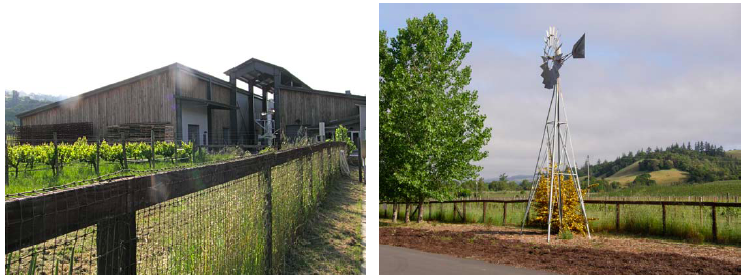
Goldeneye (named for a yellow-eyed waterfowl that occasionally calls Anderson Valley home since the region
lies in the bird’s migratory path) sources fruit from both estate and non-estate vineyards, a total of twelve
different vineyards. The lineup of wines include Goldeneye (a blend of all vineyard sources in the Anderson
Valley) and Goldeneye single vineyard estate and reserve Pinot Noirs. A lesser-priced, but quality second
label, Migration, composed of declassified juice from the Anderson Valley, was offered previously. This is now a
separate winery under the direction of winemaker Neil Bernardi featuring Chardonnay and Pinot Noir from
multiple cool-climate winegrowing regions. In 2008, Migration produced its first Chardonnay from the Russian
River Valley, representing the first Chardonnay in Duckhorn Wine Company’s 30-year history. A companion
wine, a Migration Anderson Valley Pinot Noir is also offered. A value-priced Anderson Valley Pinot Noir is also
produced under a third Duckhorn Wine Company label, Decoy.
The Goldeneye winemaker, Zach Rasmuson, apprenticed with Warren Winiarski, the founder of Stag’s Leap
Wine Cellars. Intrigued by the challenge of producing Pinot Noir, he left Stag’s Leap in 1998 to become
assistant winemaker at Robert Sinskey Vineyards. In May 2000, he was hired as winemaker of Husch
Vineyards in the Anderson Valley, finally joining Goldeneye as winemaker in August of 2003. Owner Dan
Duckhorn looks for a big, richly fruited style of Pinot Noir and Rasmuson delivers. The latest releases are
voluptuous wines that deliver plenty of power, but are displaying more nuance compared to previous vintages.
Rasmuson says, “2007 was one of those special vintages where the wines seemed to effortlessly reflect their
vineyard origins.”
The estate program offers 96 individual blocks of Pinot Noir and 49 unique combinations of clone and rootstock
material. Though spanning only eight miles, the vineyards often display a temperature difference of as much
as 10 degrees Fahrenheit. As a result, in 2007, PInot Noir was harvested over a seven week period and over
170 individual fermentations were carried out producing 1,200 barrels of wine. The favorite ten barrels, chosen
for their extraction, ripeness and weight from Gowan Creek, Confluence and The Narrows vineyards, went into
the Goldeneye Ten Degrees bottling. It is the most rich and powerful Pinot Noir produced at Goldeneye.
Goldeneye wines are sold through a mailing list with widespread distribution of the Goldeneye Pinot Noir. The
single vineyard and special bottlings are sold through the tasting room and to mailing list members. A
comfortable visitor center and tasting room is open daily 11-4 on Highway 128 in Philo. An outdoor area with
the Confluence Vineyard in the background is perfect for picnics and relaxing. Special vineyard tours and
tastings are available by appointment (800-208-0438). The website is www.goldeneyewinery.com. Beyond the
wines reviewed here, Goldeneye offers the Anderson Valley Pinot Noir, an Estate Grown Confluence Vineyard
Lower Bench Pinot Noir, an Estate Grown Confluence Vineyard Hillside Pinot Noir, and an Estate Grown
Gowan Creek Vineyard PInot Noir (previously reviewed - www.princeofpinot.com/winery/562/).
2007 Goldeneye The Narrows Vineyard Estate Grown Anderson Valley Pinot Noir
14.5% alc., 506 cases,
$75. The coolest estate vineyard, planted in 1991 and situated on a narrow ridge top in the northern end of the
Anderson Valley. This is typically the last-picked and lowest-yielding property. The majority of this wine is from
block 20, planted to a mix of Pommard and Dijon clones, a section that the producers are particularly fond of.
·
Moderately dark reddish-purple color in the glass. Brooding aromas of black cherries and oak bark. Rich with
concentrated ripe, sweet darker fruits which have some charm but are buried in tannins now. Impressively
smooth on the palate. This wine will appeal to fans of full-bodied Pinot Noir and would make a perfect
transition wine for an ex-Cabernet drinker. A good cellar candidate. Very Good.

2007 Goldeneye Confluence Vineyard Estate Grown Anderson Valley Pinot Noir
14.5% alc., 516 cases, $75. This vineyard is located in the
heart of the Anderson Valley at the headwaters of the Navarro River and
displays a range of soils and exposures.
·
Moderately garnet in color in the
glass. Amazingly aromatic with a potpourri of cherries, brioche and
sandalwood. Delicious red cherry and raspberry flavors accented with
spice and restrained oak. Not all about fruit, with some edgy earthiness adding
character. Mild dry, suede tannins make for easy drinking now. The lightest in
weight of the four vineyard based wines and the most charming now. A great
expression of Anderson Valley Pinot Noir.

2007 Goldeneye Ten Degrees Estate Grown Anderson Valley Pinot Noir
14.5% alc., 222 cases, $100.
·
Moderately dark reddish-purple color
in the glass. Very hard to coax much out of the nose after opening. The
next day the wine had taken on much more aromatic interest with scents
of berry jam, cassis and spiced plums. A robust, deeply flavored, tannic
wine that has a good lift of complimentary acidity to bring everything into
balance. Much better tasting over time in the glass and spectacular the next day
where a stunning fruit core arrives at the forefront. This is not a wine for the
timid, but for those who yearn for this hedonistic style, this is your Holy Grail.
Definitely decant this wine if you open it now.
Williams Selyem
Russian River Valley, Sonoma County, California
The story of this fabled winery has been well-chronicled in the pages of the PinotFile over the years. In 1997,
businessperson John Dyson bought the Williams Selyem Winery from Burt Williams and Ed Selyem, who were
among the first garagiste Pinot Noir producers in Sonoma County. Bob Cabral was hired as winemaker, a
28,000 square foot winery and hospitality center opened on Westside Road in 2010, new estate vineyards
(they now own 70 acres) were acquired or planted, new vineyard sources were obtained, and the Williams
Selyem flag remains flying high.
Annual production has gradually increased to over 14,000 cases and prices have crept up but quality remains
top notch. Cabral (photo below) has gradually found his footing since his arrival as he has gained familiarity
with the winery’s vineyard sources, backing off on alcohol and fruit extraction in favor of more charming and
nuanced Pinot Noirs. 40% of production is estate grown. The winery produces a variety of blended and
vineyard-designated Pinot Noirs as well as Chardonnays and Zinfandels.

Williams Selyem wines are sold exclusively through a large mailing list of faithful customers. In the last year or
two, small amounts of wine have been made available to those not on the list who call to purchase. Once a
purchaser buys at least one bottle, they become a friend of the winery, stay on the mailing list, and have
access to the winery’s hospitality center and tasting room which is not open to the public. Friends of the winery
may also enjoy tours of the property and have access to some of the small production wines only available at
the winery. The winery website is www.williamsselyem.com.
Along with the 2008 vintage Pinot Noirs reviewed here, two additional wines were included in the last issue in a
feature on the Middle Reach sub-region of the Russian River Valley and I have added them here again for
completeness. I loved the 2007 vintage Pinot Noirs from Williams Selyem and found the 2008 vintage wines
more inconsistent in quality, but some bottlings are first rate. Beyond the wines reviewed below, the following
were offered in 2008: Westside Road Neighbors, Flax Vineyard, Peay Vineyard, Weir Vineyard, Ferrington
Vineyard, Coastlands Vineyard, Hirsch Vineyard, Litton Estate Vineyard, and Precious Mountain Vineyard.
Appellation wines included: Central Coast, Sonoma County, Sonoma Coast and Russian River Valley.
2008 Williams Selyem Vista Verde Vineyard San Benito County Pinot Noir
14.1% alc., pH 3.49, $54.
Released fall 2010. This heavy limestone vineyard is located near Hollister in the Central Coast. Clones are
Calera, Canada and Pommard. Aged 18 months in 70% new and 30% 1-year-old French oak barrels.
·
Intriguing
aromas of dark red fruits, plum sauce, rose petals and oak. An individualistic wine sporting bright acidity to
bring the berry and red plum fruit to life. A subtle spice cake component adds interest. Very smoothly textured
with slippery tannins making for an easy and pleasurable drink. Good.
2008 Williams Selyem Bucher Vineyard Russian River Valley Pinot Noir
13.7% alc., pH 3.50 $54.
Released fall 2010. This vineyard is located 1.5 miles north of Williams Selyem winery on Westside Road.
Planted primarily to Dijon clones 667 and 777. Aged 17 months in 70% new and 40% 1-year-old French oak
barrels.
·
Aromas of Bing cherries, tarry oak, spice and oil. A medium-weighted cherry-driven wine with an
herbal oak and smoky underpinning that I find unpleasant. Soft and delicate, with fine dry tannins and a
respectable grip of acidity on the finish. I suspect I got a bad bottle. Decent.
2008 Williams Selyem Rochioli Riverblock Russian River Valley Pinot Noir
14.2% alc., pH 3.49, $78. Released fall 2010. Aged 18 months in 70% new and
30% 1-year-old French oak barrels.
·
Moderately deep reddish-purple color in the
glass. Brooding nose with reserved array of dark Pinot fruits. The following day,
the wine had blossomed with considerable more aromatic interest including
scents of ripe dark berries and currants, spice and cola. Luscious core of classy
fruit enhanced by notes of brown spice and cherry cola. Smooth and appealing
in the mouth with restrained fuzzy tannins and a lively acid lift on the intensely
fruity finish. Much better tasting the next day with an impressive array of broad
flavors that could only come from the Rochioli Vineyard. Hold this one for a few
years in the cellar and then party on. Very good.

2008 Williams Selyem Allen Vineyard Russian River Valley Pinot Noir
14.1% alc., pH 3.50, $78 Released fall 2010. From a vineyard planted in
the early 1970s. Aged 18 months in 60% new and 40% 1-year-old French
oak barrels.
·
Moderately light reddish-purple hue in the glass. Shy, but
very bracing aromas of red cherry and berry fruits with a hint of cut
flowers and wintergreen. Flat-out delicious core of strawberry and black
cherry cola flavors that saturate the mid-palate. Very smooth and sexy with a
proper acid backbone to pitch the fruit. A seductive wine now, but needs more
time to fully mature. All you can ask for in a Middle Reach Pinot Noir.

2008 Williams Selyem Eastside Road Neighbors Russian River Valley Pinot Noir
14.4% alc., pH 3.60, $49. Released fall 2010.
Composed of fruit from vineyards located along Eastside Road including
Calegari Vineyards, Black Rose Vineyard, Lone Oak Vineyard and Foss
Vineyard. Aged 16 months in 65% new and 35% 1-year-old French oak
barrels.
·
Moderate reddish-purple color in the glass. Wonderful aromatics
flush with spicy cherries and strawberries. Delicious dark red fruits with nuances
of Coca-Cola and spice, lingering on the finish. Very smooth and seductive in
the mouth with enough tannic backbone to support longevity. No oak crops up
to spoil the party. Very close to the old Williams Selyem style and a wine that
speaks Middle Reach loudly.




